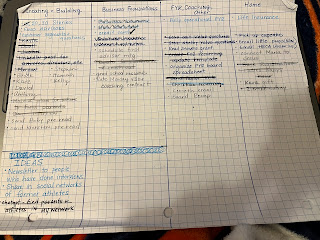The Productivity Tools That Work For Me
I’ve done a lot of experimenting with productivity mindsets and tools. Initially, it was all about producing more in less time—because as an executive and mom of three, there never seemed to be enough hours in the day.
But what I eventually realized was that I didn’t need tactics to produce more in less time—I was actually craving space for deeper work. I needed to step out of the constant barrage of urgent-but-not-important tasks and focus on the work that truly moved the ball forward.
Emails. Teams messages. Back-to-back meetings. Adding the missed comma in a deck for tomorrow’s meeting. By the time lunch rolled around, my brain was fried—leaving no room for the big rocks that actually mattered. And that includes time with my family.
I’ve explored all the strategies. There was even a phase where I took cold showers before big meetings to ride the wave of adrenaline for focus and attention. (Spoiler alert: I like hot showers, and those meetings weren’t that important.)
I’ve learned from Adam Grant, Seth Godin, Cal Newport, Andrew Huberman, and Stephen Covey. And after years of testing, these are the habits that have actually stuck:
The Productivity Habits That Changed Everything
- NOT Multi-Tasking (Especially in Virtual Meetings) – Multi-tasking is a trap. We think we’re getting more done, but in reality, we’re just doing a poor job at two things while retaining very little from either. If I ever felt the urge to multi-task during a meeting, I asked myself: “If I don’t need to pay full attention, do I even need to be in this meeting?” Sometimes, the answer was no—and that was good feedback in itself. Paying full attention wherever I am makes my brain less tired and my relationships deeper.
- Turning Off ALL Notifications – I get zero notifications on my phone or laptop, except for texts and calls. No Teams, no email, no social media (which isn’t on my phone at all), no daycare pictures. This doesn’t mean I don’t respond—I do, and always in a timely manner—but I do it when I decide to, not when a ping tells me to. The difference is massive.
- Checking Email LESS – Before learning from Cal Newport, I’d check email first thing in the morning, thinking it helped me organize my day. In reality, it hijacked my focus and dictated my priorities before I even had a chance to think. I’d end up working on the real priorities late at night or on weekends because my day had been spent crafting the perfect response to an idea that might never even happen (brutal). Now, I check email once or twice a day, never in the morning, and include a note in my signature letting senders know they can text me if something is urgent. This is still the hardest habit to maintain because email feels productive—but it’s rarely the work that actually moves the needle.
- Building 90-Minute Focus Blocks – I still do this, even though my work life looks completely different now. There’s something powerful about sitting down with no distractions, having a clear focus, and just working. The first 20 minutes are always the hardest, but then I settle into flow. Before I started blocking these chunks of time (which, at one point, only existed at night), I rarely got more than 20 minutes of deep focus. And without deep focus, deep work doesn’t happen. Bonus that there is a lot of science behind this specific length of time. Check out the work of neuroscientist Andrew Huberman on the topic.
- Blocking One Full No-Meeting Day Per Week – This sounds extreme, but nearly every piece of critical work I’ve produced in the last two years started on a no-meeting day. I’d take a long walk, eat lunch away from my computer, and think big picture about the problems I was solving. Then I’d actually have time to align the team and execute.
- Top-Down Planning – This tool, from Cal Newport’s Slow Productivity, changed the way I approach work. Instead of a never-ending to-do list, I break annual or quarterly goals into weeks and map out the big rocks for the upcoming week. I batch similar work together so that I’m moving forward on my actual priorities, not just reacting. Every Friday afternoon, I plan the upcoming week and schedule focus blocks accordingly.
If you define productivity as creating meaningful thought leadership and results, you have to create space for that work to happen. And that comes at the cost of being available to anyone and everyone at all times.
It’s far easier to spend the day responding to emails, answering messages, and checking off small tasks—because those are the systems that exist around us. But real focus? Deep work? That requires intention. And while it takes effort to create space, it’s the only way to trade busyness for true productivity.
 |
| Top-Down Planning : I carry this paper everywhere and build a new one each week |
.JPG)
.jpeg)
Comments
Post a Comment